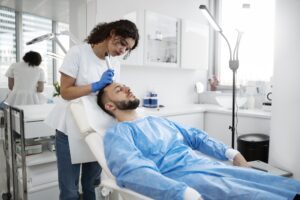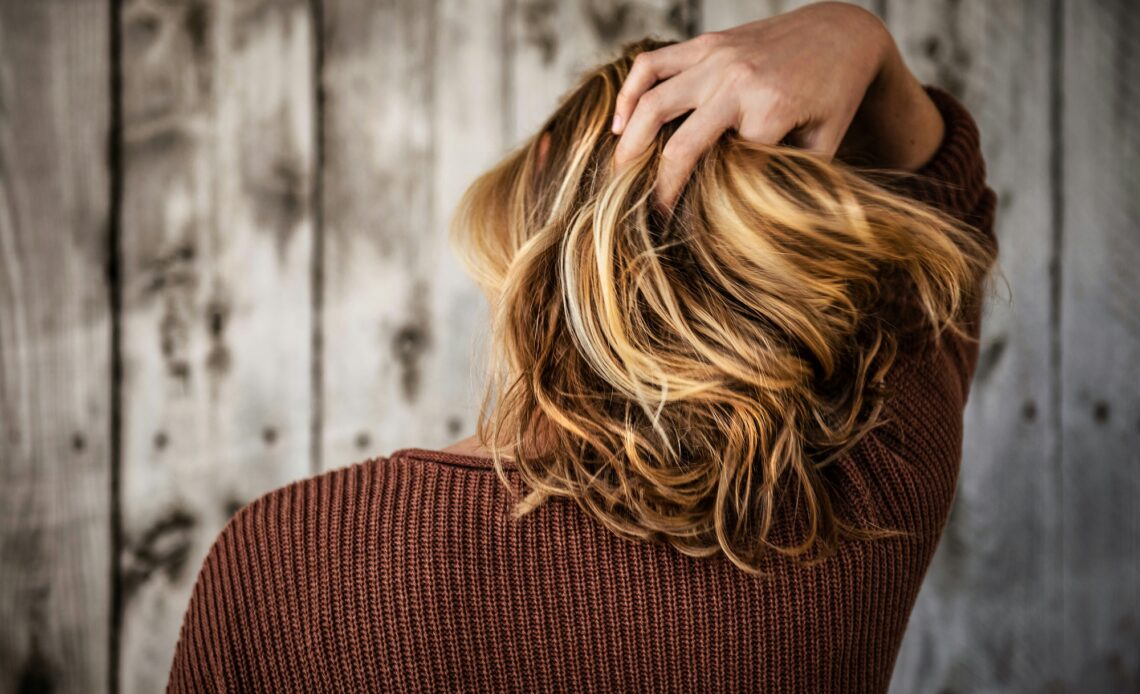Introduction
Hair loss is a very common condition that can affect both men and women. According to the American Academy of Dermatology, 80 million men and women in America have some degree of hair loss. For many, it can be an extremely distressing condition that affects self-esteem and emotional wellbeing. There are a variety of medical and cosmetic treatments available that show promise for improving hair growth.
Hair loss occurs when hair follicles shrink over time leading to thinner, more brittle strands of hair. Eventually the follicles stop producing new hairs. The most common form of hair loss is androgenetic alopecia, also known as female or male pattern baldness. This genetic condition accounts for 95% of hair loss and causes a receding hairline and bald spot on the crown of the head.
Other factors like medical conditions, medications, stress, autoimmune disorders and nutritional deficiencies can also contribute to excessive shedding and hair thinning. People experiencing hair loss often desperately seek solutions to stop hair falling out and regrow a full head of hair.
Causes of Hair Loss

The most common cause of hair loss is androgenetic alopecia, also known as male or female pattern baldness. This condition accounts for over 95% of hair loss and results in a progressive thinning of the hair.
Androgenetic alopecia is caused by the effects of dihydrotestosterone (DHT), a hormone that is converted from testosterone with the aid of 5-alpha reductase enzymes. DHT causes hair follicles to shrink gradually, resulting in shorter, finer, and lighter hairs until the follicles no longer produce visible hair. The rate of hair loss can vary greatly between individuals.
Genetics play a key role in androgenetic alopecia. Those with a family history are more likely to experience hair thinning and pattern baldness at a younger age. However, lifestyle factors like stress and diet also impact the hair growth cycle and may exacerbate genetic susceptibility.
While androgenetic alopecia is the most prevalent hair loss type, other factors like illness, medication side effects, hormonal changes, and autoimmune disorders can also trigger excessive shedding or thinning. But in most cases of progressive hair loss, DHT is the main culprit that causes follicles to degrade over time.
Lifestyle Changes
Hair loss can sometimes be aggravated by stress, poor nutrition, and other lifestyle factors. Making positive changes to your daily habits and routine can help mitigate hair loss in some cases.
Stress Reduction
Chronic stress produces high levels of cortisol and other hormones that can interfere with the hair growth cycle. Finding ways to manage stress through meditation, yoga, counseling, or other stress relief techniques can normalize hormone levels. Reducing stress where possible in your work and home life is also important.
Nutrition
Ensuring you get enough protein, iron, zinc, vitamin D, and other nutrients vital for hair health can help reduce shedding. Take a supplement if your diet is deficient in any of these. Getting sufficient calories for your level of activity is also important. Severe calorie restriction and eating disorders can contribute to hair thinning.
Making lifestyle changes takes commitment but can bolster hair from the inside out. Work on identifying and modifying daily habits that may aggravate hair loss. Be patient, as it can take months for new hair growth to become visible.
Medications
There are two medications that are FDA approved and considered effective for treating hair loss: minoxidil and finasteride.

Minoxidil (Rogaine) is a topical medication that helps stimulate hair growth. It comes as a liquid or foam that you apply directly to your scalp twice daily. Minoxidil helps prolong the growth phase of hair follicles and can help regrow hair on the top of the head. It works best for people with thinning hair and is less effective for receding hairlines or bald spots. Minoxidil takes around 4 months to start seeing results and must be used continually to maintain its effects.
Finasteride (Propecia) is an oral medication that blocks the hormone DHT, which causes shrinking and miniaturization of hair follicles. By inhibiting DHT, finasteride stops further hair loss and helps regrow some hair. It comes in a pill form that is taken once daily. Finasteride can be effective at slowing hair loss for many years, but does not work for everyone. It is more effective for hair loss at the top and middle of the scalp than receding hairline or bald spots. It may take 3-6 months to notice results from finasteride.
Using minoxidil and finasteride together can be more effective than using either alone. But you should consult a dermatologist to determine if these medications are appropriate for your type and stage of hair loss. Proper use is key to getting the best results.
Low Level Laser Therapy
Low level laser therapy (LLLT) is a relatively new treatment for hair loss that is growing in popularity. It involves using low-power lasers or LEDs directed at the scalp to stimulate hair growth.
LLLT is thought to work by increasing blood flow to hair follicles, encouraging the scalp to shift from the telogen (resting) phase to the anagen (growing) phase, and energizing the metabolism of the hair follicles. The low-power light is believed to stimulate cellular activity and molecular mechanisms that encourage healthier hair production.
During a LLLT session, a cap or hood with red laser or LED light diodes is placed on the head for about 10-20 minutes. The light emitted penetrates the scalp and targets the cells needed for hair growth. Typically treatments are done 2-3 times per week for several months.
Studies show LLLT may be effective in both men and women for stimulating hair growth. A review of randomized controlled trials found LLLT increased hair density and had a positive effect on hair loss. The success rate varies based on the device used, power level, wavelength, and consistency of treatments.
While LLLT seems promising, more research is still needed to fully validate its effectiveness. It also does not address the hormonal causes of genetic hair loss. However, when used in combination with other treatments, LLLT may accelerate hair growth, making it a useful addition to a hair loss regimen.
Microneedling
Microneedling is a minimally invasive procedure that involves using tiny needles to puncture the skin. This triggers the body’s wound healing process, which results in collagen production and new tissue growth.
During a microneedling session, a dermatologist uses a specialized tool containing fine needles 0.5-2.5 mm in length to create micro injuries in the skin. The needle depth can be adjusted based on the area being treated and desired outcome. Typically, the needles penetrate deep into the dermis, but do not damage the epidermis.

As the needles pierce the skin, they stimulate collagen and elastin production. New collagen fills in valleys and scars on the skin’s surface, resulting in smoother, firmer skin. The micro-injuries also activate growth factors that encourage hair follicle stem cells. This leads to thicker, healthier hair regrowth.
Multiple microneedling treatments are required to see results. Most dermatologists recommend 4-6 sessions spaced 4-6 weeks apart. Some minor redness and irritation can occur after microneedling. Downtime is minimal, about 24 hours on average.
Research shows microneedling is effective at stimulating hair regrowth for both men and women. In one study, over 90% of patients with alopecia areata experienced significant hair regrowth after weekly microneedling sessions. The procedure has also been found effective at treating male and female pattern baldness. However, individual results vary depending on the extent of hair loss, cause, and other factors.
Overall, microneedling is a safe, non-invasive option for promoting hair regrowth. When combined with medications like minoxidil, microneedling may lead to even better results. More research is still needed to determine optimal treatment protocols. But current evidence suggests microneedling can thicken hair and reverse miniaturization for some patients with hair loss.
PRP Injections
PRP or platelet-rich plasma injections are an emerging treatment for hair loss. During the treatment, a doctor draws the patient’s blood and spins it in a centrifuge to isolate the platelet-rich plasma. The concentrated platelets contain growth factors that can stimulate hair follicle growth and prevent further hair loss.
The patient’s scalp is numbed and the PRP solution is injected into the areas of hair loss. The growth factors in the platelets may help shrink miniaturized hair follicles and stimulate inactive follicles to start regrowing hair.
Some small studies have shown PRP injections to be effective, especially when combined with other treatments like microneedling. In one study, patients received 3 PRP treatments every 3 weeks and saw an average increase in hair count of 33% after 6 months. The results seem to improve with multiple repeated treatments over time.
However, larger and longer studies are still needed to confirm the efficacy of PRP for hair loss. Results can vary greatly between individuals. Current evidence is still considered preliminary. More research is required to determine ideal treatment protocols.
While relatively safe, PRP does carry some risks like infection and bleeding. Side effects may include minor pain, redness and swelling at the injection sites. Some doctors recommend using a topical anesthetic to minimize discomfort.
Overall, PRP injections show promise for stimulating regrowth in some cases of pattern baldness. But patients need to manage expectations, as results are unpredictable and generally subtle. For those willing to undergo repeated treatments, PRP therapy may help slow or reverse early-stage hair loss when combined with other modalities.
Hair Transplants
Hair transplantation is a procedure where hair follicles are removed from one part of the scalp and transplanted to areas experiencing balding or thinning. It is one of the most effective treatments for permanent hair restoration.
The two main techniques used are:
- Follicular Unit Extraction (FUE): Individual hair follicles are extracted directly from the scalp using a punch tool. The surgeon makes small circular incisions that leave tiny dot scars. FUE allows for natural-looking results and fast healing but is more time consuming.
- Follicular Unit Transplantation (FUT): A strip of skin containing hair follicles is removed from the back of the scalp. The strip is dissected to obtain individual grafts which are then transplanted. FUT covers more area in one session but leaves a linear scar at the donor site.
In both techniques, the grafts containing 1 to 4 hairs are carefully inserted into the balding areas. The existing hair in the surrounding area helps conceal the transplanted follicles. Proper angle and direction of insertion gives a natural look.
Hair transplantation can restore hairlines, fill thinning areas, and cover bald spots for men and women. Multiple sessions are often required. Recovery is relatively quick and side effects like swelling and itching resolve within a week. When performed by an experienced surgeon, hair transplants can deliver permanent and natural-looking results.
Wigs and Hair Systems
Wigs and hair systems can be effective options for covering areas of hair loss or thinning hair. These additions allow the appearance of a full head of natural hair.
There are several types of wigs and hair systems to consider:
- Full wigs cover the entire head and are secured with wig tape or adhesive. They require removing each night. Full wigs come in synthetic and human hair. Human hair full wigs offer the most natural look and feel.
- Partial wigs cover only certain areas of hair loss, blending with existing hair. These clip or glue into place. Partial wigs come in small cap designs to fit regions like crown thinning.
- Hair toppers or toupees are partial wigs worn just on top. They attach with tape, clips, or adhesive. Hair toppers add volume in areas of the most significant hair loss.
- Custom hair systems are designed specifically for each person’s head and hair loss pattern. They offer the most seamless, natural appearance as they are made using a mold of the head. However, custom systems also come at the highest cost.
When purchasing wigs and systems, color matching one’s original hair is crucial for realism. Human hair pieces can be colored and styled the same as natural hair.
Proper wig care and maintenance will maximize longevity. Gently combing and washing with wig shampoo helps keep them in optimal condition. Proper storage on a stand or mannequin head prevents damage when not being worn.
Wigs and hair systems provide immediate cosmetic results for hair loss. With customization and proper care, they can be an effective hair addition and confidence boost.
Coping with Hair Loss
Hair loss can have a significant impact on self-esteem and self-image. Seeking support and practicing self-care are important for managing the emotional aspects of losing your hair.
- Focus on self-esteem. Remind yourself that hair does not define you or determine your worth. Your value comes from within. Surround yourself with people who appreciate you for you. Work on cultivating inner confidence. Consider speaking with a counselor if self-esteem is a major issue.
- Join support groups. Connecting with others experiencing hair loss can provide community, reduce isolation, and help you realize you’re not alone. In-person and online support groups allow for sharing advice, tips, and encouragement.
- Practice self-care. Do things that make you feel good about yourself, like exercise, hobbies, socializing, pampering, and exploring your personal style. Keep stress in check through relaxation techniques. Get enough sleep, eat nutritious foods, and boost your mood through laughter and spending time in nature.
- Consider cosmetic approaches. Hairstyling tricks, scarves and hats, hair fiber sprays, and wigs can help boost confidence while managing hair loss. Focus on enhancing natural features you love about yourself.
- Seek professional help for depression. If hair loss leads to persistent sadness, loss of interest in normal activities, or other symptoms of depression, seek help from a mental health professional. They can provide coping strategies, therapy, and medications if needed.
With the right mindset and support system, it’s possible to maintain self-confidence while dealing with changes in your hair. Focus on self-care and inner positivity.


